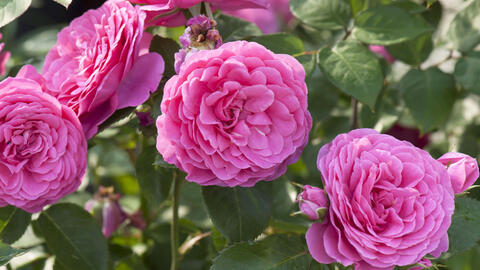The 5 Biggest Mistakes when Caring for Roses
Roses will only grow to become healthy, opulent, blooming garden beauties when cared for correctly. Let’s take a look at the most common mistakes.

In the summer months, roses really let their flower power show – as long as they have the right location and good care
A garden without roses? For many of us, unthinkable! In order to enjoy plenty of roses, there are a few things to keep in mind when choosing a planting location and caring for these classic shrubs. If you avoid the following mistakes, your bedding roses, , tea roses or titleclimbing roses will stay healthy and full of life.
There are almost no roses that enjoy shade: most varieties love the sun and appreciate a protected yet windy location in the garden. Air circulation softens high temperatures, and leaves can dry more quickly after a shower of rain. At least five to six hours of sun a day should be provided. But too much of a good thing can be harmful: the leaves will easily burn directly in front of a light south-facing wall. Roses also have some prerequisites when it comes to soil. Heavy loamy or clay soils easily become waterlogged, causing damage. The prefer things light and airy: to make your soil more permeable, work a little sand into it. Very light soil is improved with loam or humus. You should also be aware that roses can cause soil fatigue: roses should be planted where the soil has not previously been home to members of the rose family where possible.

Mistakes pruning roses happen particularly quickly. But you shouldn’t avoid pruning roses altogether, as the plants’ vitality and flowering will wane. The optimal time to prune is usually spring when the forsythias are in flower. In order to remove the nutrient source for plant diseases, all dead, infected and damaged shoots are removed. How much further pruning is required depends on the type of rose. As a rule of thumb, repeat-flowering bedding and floribunda roses should be cut back to around one third of their height, while repeat-flowering shrub roses should be pruned to around two thirds. Repeat-flowering climbing roses can be relieved of around half of their side shoots. Caution: once-blooming roses should only be pruned – if at all necessary – after flowering in the summer months.
Roses are that can reach water in deep layers of the soil. However, it is advisable to provide them with additional water immediately after planting and also during long periods of drought. It’s best to water your roses in the morning and not in the bright midday sun, as burning may occur. Wetting the leaves should be avoided at all costs: this encourages the spread of fungal diseases such as black spot and mildew. The motto is: it’s best to generously water once to twice a week rather than water meagerly every day.

The nutrient requirements of roses are not to be underestimated: these woody, flowering plants are strong uptakers, preferring neutral to slightly acidic soil. Roses are first fertilized in spring after the main prune. Rose lovers provide their roses with well-rotted or pelleted cattle manure – or organic rose fertilizer, distributed around the root area and worked into the soil. If a soil analysis has shown that the soil contains enough phosphorous and potassium, then horn shavings will be sufficient. Repeat-flowering roses are fertilized once again after the summer prune – ideally using a mineral fertilizer like fast-acting Blaukorn. A word of caution: one dose should not exceed 0.88 ounces per 1.2 square yards. The final nitrogen feed should be supplied by the start of July: otherwise, the shoots will not mature by winter. This makes them vulnerable to frost damage.

Sadly, not all roses are completely winter hardy – grafting sites in particular are very sensitive to frost. If roses are not provided with winter protection, these woody plants can be damaged not only by cold but also by drying winds and winter sun. You should take a pro-active approach in fall, when the first ground frosts arrive. Shovel soil onto the shooting base and cover any protruding shoots with a tent of evergreen mulch. Tree roses should have their entire crowns covered with fleece or jute.



